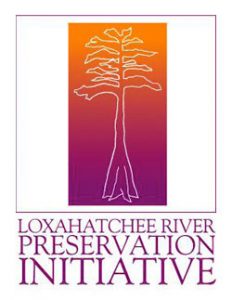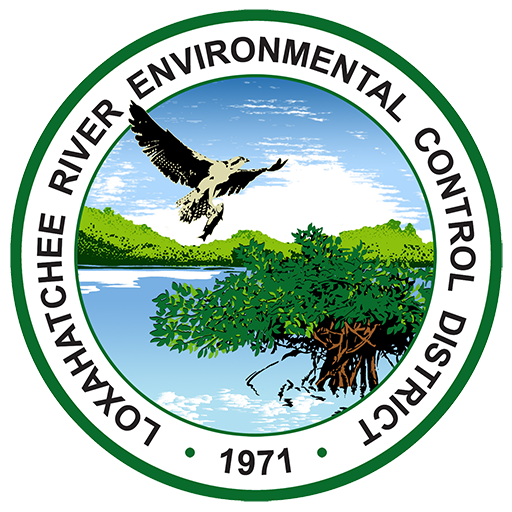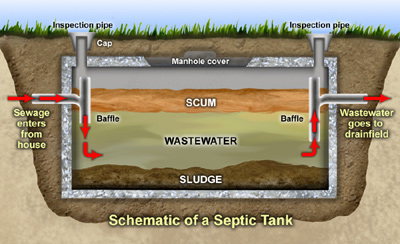Are you properly maintaining your septic tank system? By properly installing and maintaining your septic system, you can help to limit the amount of pollutants that reach the environment, and you can save money on repairs. As part of a public service program, The Loxahatchee River District has created a quick information guide to help you better care for your septic system. We encourage you to read this brochure and practice the methods described.
How Your Septic System Works
Wastewater flows from your house into the septic tank where heavy solids settle to the bottom. The settled material is called sludge. It accumulates and must be removed periodically, every 2-5 years, by pumping the septic tank. Oils and other lighter particles float near the surface and form a layer of scum.
The wastewater then leaves the tank through a pipe and enters the drain field. Baffles prevent sludge or scum from entering the drain field. Wastewater is channeled through perforated pipes allowing the water to slowly seep into the underlying soil.
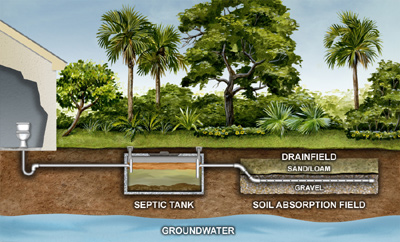
Dissolved wastes and bacteria are then decomposed by microorganisms and nutrients are absorbed into the soil. This process removes most organic matter, disease-causing organisms, and nutrients. Treated wastewater then percolates down through the soil and recharges the ground water that may be treated for drinking water.You can learn more about septic system here.
Maintenance Requirements
Regular maintenance and inspection of your septic system will help to limit the amount of pollutants reaching the environment and improve the health of your septic system.
- Inspect your tank annually to determine sludge depth. Have your tank pumped to remove sludge every 2-5 years. It should be pumped and inspected by a licensed professional. For more information about suggested pumping frequencies, please see Table 2 below.
- Plant only grass or other shallow rooted plants above your septic system. Trees should be planted away from the system because their roots can damage the pipes or the tank.
- Direct down spouts and rain runoff away from the septic area to avoid saturating the area with water.
- Do not compact the soil above the septic system. Avoid parking cars or building any structures (e.g. sheds) in the area.
- Avoid using a garbage disposal. Increasing the amount of solid waste in your septic system will shorten the amount of time between pumpings.
- Place paper towels, facial tissues, cigarette butts, disposable diapers, feminine products, and other material in a trash can, not the toilet. These items do not break down quickly and may clog the septic system. Toilet paper breaks down quickly and therefore can be placed in the toilet.
- Overloading the system can occur in the early morning and evenings when water use is highest. Run dishwashers and washing machines at other times of the day. Avoid doing all the family’s laundry on the same day. Practice water conservation in all areas of water usage.
- Fats and oils poured down the drain may build up and clog septic system pipes.
- Do not use chemicals or cleaners in your septic system. They may harm the septic system.
Septic Tank Size Requirements – Table 1
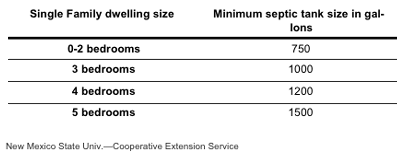
Pumping Frequency – Table 2

History of Service
In 1971, the Loxahatchee River District was formed to protect the Loxahatchee River and the water resources of the area. At the time, there were thirteen mini sewage treatment plants releasing wastewater into the Loxahatchee River, in addition to approximately 3,000 septic systems in the area. The District established a regional wastewater utility for existing development ,and to ensure that future development would not harm the Loxahatchee River through wastewater discharges.
By the mid-1980s, the small treatment plants had been eliminated and the District began sewering existing neighborhoods close to the River. Older neighborhoods that still have septic systems often have inadequate drainage, and they are more likely to release pollutants into our environment. This is why it is essential to properly install and maintain septic systems.
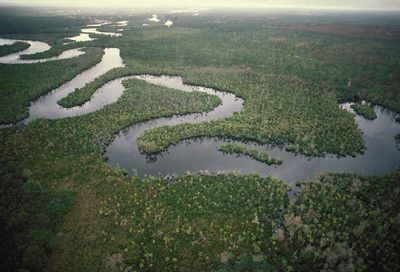
The Loxahatchee River District is dedicated to preserving the Loxahatchee River as a natural resource for our community.
Regional Sewer System
If you are experiencing problems with your septic system and would like information about how to connect to the sewer system, we encourage you to contact the Loxahatchee River District Engineering Department for guidelines and procedures. (561) 747-5700, Option 3.
Preserving Nature By Design
Your local wastewater treatment facility is owned, operated, and maintained by the Loxahatchee River Environmental Control District. Located in Jupiter, it serves the municipalities of Jupiter, Tequesta, Juno Beach, along with unincorporated areas of northern Palm Beach and Martin Counties. The River District has been a leader in wastewater management, treatment, and reuse. The River District has been the recipient of numerous awards for excellence in wastewater treatment, including the Florida Engineering Society, the State of Florida Department of Environmental Protection’s Phelps Awards, the Florida Water Environment Association’s prestigious David W. York Award, and the United States Environmental Protection Agency’s highest honor, Best in Nation.

2500 Jupiter Park Drive
Jupiter, FL 33458
Phone: 561-747-5700
Fax: 561-747-9929
E-mail: info@lrecd.org
Web: www.loxahatcheeriver.org
This project was provided by the
Loxahatchee River District
in cooperation with the
Loxahatchee River Preservation Initiative
(www.lrpi.us)
